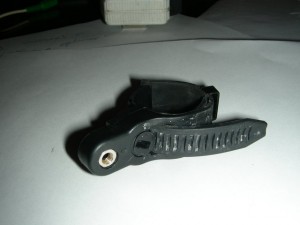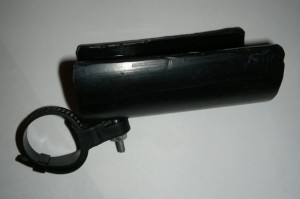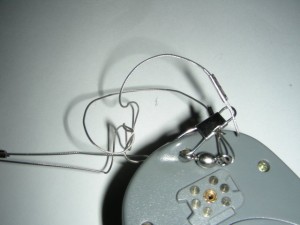I can be a bit of a “geardo” sometimes, and can be carrying any number of electronic devices at any given time. I have a Magellan GPS that love using for mapping trails out or city routes that I feel are worthy of recording. I have always wanted one of those expensive GPS holder solutions on the market. But just can never justify the price for something that I will for sure smash in the the first one to two months of ownership. So i came up with a cheap replaceable DIY holder for my GPS.
I ‘ll show you how I made it, just in case you you have some kind of electronic Fred gear that needs to be mounted to your bike.
Get one piece of PVC pipe about the length of your GPS. I used 2 1/2 inch, black PVC from the Home Despot.
Now take a jig saw and make a horizontal cut down the tube, making a single straight cut through one wall of the tube. Now here is the tricky part, and it may take you many tries, with many pieces of the PVC pipe to get it right. But hey, PVC pipe is pretty cheap for a 5 foot length.
You have to make the second cut at just the right spot, so that there is some gripping force or “cradle” effect on your GPS or electronic device. The pipe has great has a slight flexibility that it retains no matter how many times you flex it.
Now get one of the many bar clamping reflector/light /bell /last thing fell or broke off your bike, holder things. All of these bar retaining systems share the same pivot which usually is all you have left after it breaks off your seat post or handlebars. So if you’re like me, they are easy to come by and you already have a shoe box full of these things.
The pivot will usually have a bolt going through the center, but for the this purpose you’ll need a longer bolt with a nut and 2 washers.
Drill a hole through the center of the cradle the size of your bolt near one end. You can make make the hole depending on where you want the GPS holder located on your handle bars.
Mount the PVC cradle to the bar clamp with the bolt and nut. Use a washer on both sides for a nice snug fit.
Do it a test fit and clamp your GPS into the PVC cradle. You want to be sure it takes some force to dislodge it. You can apply pressure from the insides the pipe, and outwards to release the GPS. In my case the the Magellan doesn’t touch the back of the tube, but it your device does, you can throw in some foam to cushion or prevent scratches. This extra space also gives me some ability to tilt the GPS up or down after it been locked to the handlebars.
I softened the the hard edges of the pipe with a knife, to give it that perfect production quality look. You could sand it, paint it a different color or carve it into any shape depending on your level of creativity or prowess with a Dremel or wood carving kit. The PVC is pretty malleable.
I use a couple of 20 lbs fishing leaders linked together, as a lanyard strap hooked to a carabiner as extra security. Just in case the GPS were to fall out on a jump or accidental crash. I usually clip it to one of the brake lines. Unless I’ve got a lunker on the other end, that GPS is going anywhere! Anyway have fun building gang.








